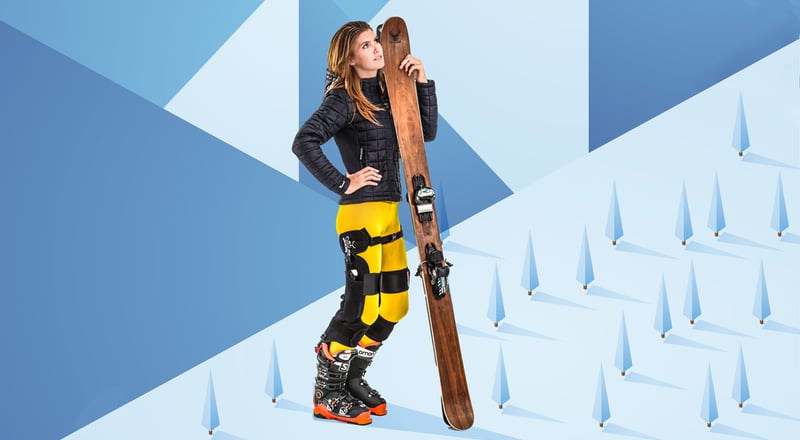¿Qué dicen las mujeres sobre el Ski Mojo?
Chemmy Alcott
Four-time Winter Olympian and Britain’s most successful female downhill skier, Chemmy Alcott is a huge advocate of the Ski~Mojo. She told us how it helped her road to recovery following some serious knee injuries:
“I needed something to take the pressure off my knees”
“If you Google my name I seem to be more well-known as someone who has come back from a quite horrific injury than the four Winter Olympics I went to!. I had a serious ACL (Anterior Cruciate Ligament) tear and surgery after I retired from racing and this had an impact on my coaching work. I needed to find solutions quickly and something to take the pressure off my knees, so I didn’t have to take painkillers or anti-inflammatories.
I wanted something that could help me go out there and perform better and for longer. The Ski Mojo really ticked every box for me. The first time I tried the Ski Mojo was just after an ACL reconstruction. I wanted to be able to ski hard, while still coming back from injury and protecting my knees”.
“It enabled me to perform even better…”
“What I found was that it enabled me to perform even better – it helped me charge the turn right at the top by actively powering my hip up and forward into the transition. If I’m coaching and out on the mountain all day long, the difference it makes now is significant. I need to protect my knees for the longer term and the Ski Mojo simply takes that strain away. What I really like is how it helps enhance performance too – not only helping at the top of the turn, but also aligning the lower part of the body into a natural ski position. It’s an excellent tool for coaching and teaching too”.
“There’s a place for the Ski Mojo for all levels of skier…”
“Despite helping with my performance, I believe there’s a place for the Ski Mojo for all levels of skier. It’s not just for pros. My mother-in-law has used the Ski Mojo for skiing over the past ten years after a lot of medics said her skiing life was over. She wanted to prove them wrong, so she invested in the Ski Mojo for that reason”.
Alexandra, Ski instructor in Val d'Isère
Alexandra is a ski instructor in Val d’Isère. She has suffered from knee pain for several years but was too young to be eligible for a knee prosthesis. It was not without apprehension that she ended up testing the Ski~Mojo. And obviously, it was a very good surprise …
Heidi Zurbriggen, Ski instructor in the Saas Fee valley
Heidi is a Swiss skier, a two-time silver medallist at the Alpine World Ski Championships and winner of three World Cup runs.
After retiring from her professional career, Heidi became a ski instructor but, like many former top athletes, her knees hurt all day long. Thanks to Ski~Mojo, Heidi can now ski all day without pain or strain.
Even younger skiers are crazy about it ! Saas Fee Rocks
Ophélie and Andrea tested the Ski-Mojo in Saas Fee. In their own words, it’s AMAZING. It helps improve their technique. Augmented skiing gave them a blast.
I tested the Ski~Mojo
By Mélanie Marullaz – 17 février 2019
PHYSICS EXERCISE !
AT AUSTIN POWERS, MOJO IS A CLEVER MIX OF LUCK, CHARM AND SEXUAL VIGOUR THAT MEANS THAT NOTHING STANDS IN HIS WAY, DIFFICULT MISSIONS OR WOMEN. BUT APPLIED TO SKIING, WHAT DOES MOJO MEAN? THE ABILITY TO SWALLOW THE BELLEVARDE FACE OR THE SWISS WALL WHILE REMAINING INCREDIBLY SEXY?
The Ski-Mojo, I am told, is an exoskeleton. At this word, I switch from Austin, from Powers to Steve, the one worth 3 billion, and imagine myself hurtling down the slopes – looking like I’m in slow motion – with a metallic boomerang sound. But I’m taken back: Steve Austin is a bionic man, transformed from the inside out; an exo-skeleton, on the other hand, is an external structure, attached to one or more limbs of the human body, which allows it to regain mobility or increase its capabilities. The concept has mainly been developed in the military and industrial fields or in connection with motor disabilities, but in this version adapted to the world of sliding, it is for you and me, who are neither warrior nor handler, and still in good working order.
POSITIONING STATEMENT
So I set off to test it in real conditions in Avoriaz, with Jean-Marc Glaude, the Mojo-master. He starts by attaching temporary supports to my ski boots – the day I get my own exoskeleton, he’ll screw them on permanently. I then slip into what looks like a harness, strapped in at pelvis level. Between the two, Jean-Marc installs on the side of each leg the famous skeleton – the model for people under 75kg, there is another one for the strongest – which consists of two neoprene-covered tubes articulated around a large spring. It’s a so-called «unloading» mechanism, once engaged, it should relieve me of 1/3 of my weight, absorb shocks and limit, if necessary, the pain in my back, hips and knees. I wear it on my spindle, but it could just as easily be slipped under a pair of trousers. A few more adjustments for my size and I’m off!

CASE STUDY
I immediately want to put my body weight backwards, to better feel the effects of the equipment. Unless I want to let my spatulas live their own life, it’s a bad idea, obviously. But once I put the equipment back on correctly, it was difficult to evaluate the benefits in the first few turns. Until the middle of the third descent, when, once I’m used to my shell, the Mojo-master asks me to disengage the system. Each of my legs then seems to weigh 10 tons and my buttocks double that! No more lightness, back to gravity. It was even more obvious at the end of the test: in very little autumn shape for this restart, after 6 runs at full speed, my legs were barely tired. But, on the way back, unloaded from the exo, I have to stop every three turns to re-oxygenate my thighs, which literally burn from the inside. With my tongue hanging out and my cheeks crimson, there’s nothing sexy about me anymore… I want my mojo back!

